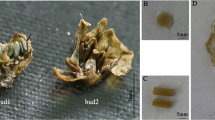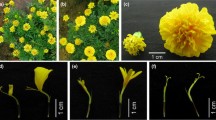Abstract
PsEND1 is a pea anther-specific gene that displays very early expression in the anther primordium cells. Later on, PsEND1 expression becomes restricted to the epidermis, connective, endothecium and middle layer, but it is never observed in tapetal cells or microsporocytes. We fused the PsEND1 promoter region to the cytotoxic barnase gene to induce specific ablation of the cell layers where the PsEND1 is expressed and consequently to produce male-sterile plants. Expression of the chimaeric PsEND1::barnase gene in two Solanaceae (Nicotiana tabacum and Solanum lycopersicon) and two Brassicaceae (Arabidopsis thaliana and Brassica napus) species, impairs anther development from very early stages and produces complete male-sterile plants. The PsEND1::barnase gene is quite different to other chimaeric genes previously used in similar approaches to obtain male-sterile plants. The novelty resides in the use of the PsEND1 promoter, instead of a tapetum-specific promoter, to produce the ablation of specific cell lines during the first steps of the anther development. This chimaeric construct arrests the microsporogenesis before differentiation of the microspore mother cells and no viable pollen grains are produced. This strategy represents an excellent alternative to generate genetically engineered male-sterile plants, which have proved useful in breeding programmes for the production of hybrid seeds. The PsEND1 promoter also has high potential to prevent undesirable horizontal gene flow in many plant species.




Similar content being viewed by others
Abbreviations
- GUS:
-
β-Glucuronidase
- nptII :
-
Neomycin phosphotransferese II gene
- PCR:
-
Polymerase chain reaction
- uidA :
-
β-Glucuronidase gene
References
Beals TP, Goldberg RB (1997) A novel cell ablation strategy blocks tobacco anther dehiscence. Plant Cell 9:1527–1545
Bechtold N, Ellis J, Pelletier G (1993) In planta Agrobacterium mediated gene transfer by infiltration of adult Arabidopsis thaliana plants. C R Acad Sci Paris, Life Sci 316:1194–1199
Bedinger P (1992) The remarkable biology of pollen. Plant Cell 4:879–887
Canales C, Bhatt AM, Scott R (2002) EXS, a putative LRR receptor kinase, regulates male germline cell number and tapetal identity and promotes seed development in Arabidopsis. Curr Biol 12:1718–1727
Cañas LA, Essid R, Gómez MD, Beltrán JP (2002) Monoclonal antibodies as developmental markers to characterize pea floral homeotic transformations. Sex Plant Reprod 15:141–152
Damgaard O, Jensen LH, Rasmussen OS (1997) Agrobacterium tumefaciens-mediated transformation of Brassica napus winter cultivars. Transgenic Res 6:279–288
De Block M, Debrouwer D, Moens T (1997) The development of a nuclear male sterility system in wheat. Expression of a barnase gene under the control of tapetum specific promoters. Theor Appl Genet 95:125–131
Denis M, Delourme R, Gourret JP, Mariani C, Renard M (1993) Expression of engineered nuclear male-sterility in Brassica napus. Plant Physiol 101:1295–1304
Ellul P, García-Sogo B, Pineda B, Ríos G, Roig LA, Moreno V (2003) The ploidy level of transgenic plants in Agrobacterium-mediated transformation of tomato cotyledons (Solanum lycopersicon L. Mill.) is genotype and procedure dependent. Theor Appl Genet 106:231–238
Fisher DK, Guiltinan J (1995) Rapid, efficient production of homozygous transgenic tobacco plants with Agrobacterium tumefaciens: a seed to seed protocol. Plant Mol Biol Rep 13:278–289
Goldberg RB, Beals TP, Sanders PM (1993) Anther development: basic principles and practical applications. Plant Cell 5:1217–1229
Gómez MD, Beltrán JP, Cañas LA (2004) The pea END1 promoter drives anther-specific gene expression in different plant species. Planta 219:967–981
Hartley RW (1988) Barnase and barstar expression of its cloned inhibitor permits expression of a cloned ribonuclease. J Mol Biol 202:913–915
Hewitt YM (1966) Sand and water culture methods used in the study of plant nutrition. Farnham Royal, Bucks. Commonwealth Agricultural Bureaux
Hird DL, Worral D, Hodge R, Smartt S, Paul W, Scott R (1993) The anther-specific protein encoded by the Brassica napus and Arabidopsis thaliana A6 gene displays similarity to β-1,3 glucanases. Plant J 4:1023–1033
Hood EE, Helmer GL, Fraley RT, Chilton MD (1986) The hypervirulence of Agrobacterium tumefaciens A281 is encoded in a region of pTiBo542 outside of T-DNA. J Bacteriol 168:1291–1301
Horsch RB, Fraley RT, Rogers SG, Sanders PR, Lloyd A, Hoffmann N (1984) Inheritance of functional foreign genes in plants. Science 223:496–498
Kawanabe T, Ariizumi T, Kawai-Yamada M, Uchimiya H, Toriyama K (2006) Abolition of the tapetum suicide program ruins microsporogenesis. Plant Cell Physiol 47(6):784–787
Koltunow AM, Truettner J, Cox KH, Wallroth M, Goldberg RB (1990) Different temporal and spatial gene expression patterns occur during anther development. Plant Cell 2:1201–1224
Koning A, Jones A, Fillati J, Comai L, Lassner MW (1992) Arrest of embryo development in Brassica napus mediated by modified Pseudomonas aeruginosa exotoxin A. Plant Mol Biol 18:247–258
Lee Y-H, Chumg K-H, Kim H-U, Jin Y-M (2003) Induction of male-sterile cabbage using a tapetum-specific promoter from Brassica campestris L. spp. pekinensis. Plant Cell Rep 22:268–273
Ma H (2005) Molecular genetic analyses of microsporogenesis and microgametogenesis in flowering plants. Annu Rev Plant Biol 56:393–434
Mariani C, De Beuckeleer M, Truettner J, Leemans J, Goldberg RB (1990) Induction of male sterility in plants by a chimaeric ribonuclease gene. Nature 347:737–741
Mariani C, Gossele V, De Beuckeleer M, De Block M, Goldberg RB, De Greef W, Leemans J (1992) A chimaeric ribonuclease inhibitor gene restores fertility to male sterile plants. Nature 357:384–387
Murashige T, Skoog F (1962) A revised medium for rapid growth and bioassays with tobacco tissue cultures. Physiol Plant 15:473–479
Nasrallah JB, Nishio T, Nasrallah ME (1991) The self-incompatibility genes of Brassica: expression and use in genetic ablation of floral tissues. Annu Rev Plant Physiol, Plant Mol Biol 42:393–422
Nonomura K-I, Kazumaru M, Eiguchi M, Suzuki T, Miyao A (2003) The MSP1 gene is necessary to restrict the number of cells entering into male and female sporogenesis and to initiate anther wall formation in rice. Plant Cell 15:1728–1739
Paul W, Hodge R, Smartt S, Draper J, Scott R (1992) The isolation and characterization of the tapetum-specific Arabidopsis thaliana A9 gene. Plant Mol Biol 19:611–622
Roberts MR, Boyes E, Scott RJ (1995) An investigation of the role of anther tapetum during microspore development using genetic cell ablation. Sex Plant Reprod 8:299–307
Rogers SO, Bendich AJ (1984) Extraction of DNA from milligram amounts of fresh, herbarium and mummified plant tissues. Plant Mol Biol 5:69–76
Sanders PM, Bui AQ, Weterings K, McIntire KN, Hsu Y-C, Lee PY, Truong MT, Beals TP, Goldberg RB (1999) Anther developmental defects in Arabidopsis thaliana male-sterile mutants. Sex Plant Reprod 11:297–322
Sambrook J, Fritsch EF, Maniatis T (1989) Molecular cloning. A laboratory manual. Cold Spring Harbor Laboratory Press, New York
Schiefthaler U, Sureshkumar B, Sieber P, Chevalier D, Wisman E, Schneitz K (1999) Molecular analysis of NOZZLE, a gene involved in pattern formation and early sporogenesis during sex organ development in Arabidopsis thaliana. Proc Natl Acad Sci 96:11664–11669
Scott RJ, Hodge R, Paul W, Draper J (1991) The molecular biology of anther differentiation. Plant Sci 80:167–191
Scott RJ, Spielman M, Dickinson HG (2004) Stamen structure and function. Plant Cell 16(suppl):S46–S60
Smulders MJM, Rus-Kortekaas W, Gillissen LJW (1995) Development of polysomaty during differentiation in diploid and tetraploid tomato (Solanum lycopersicon) plants. Plant Sci 97:53–60
Theis R, Röbbelen G (1990) Anther and microspore development in different male sterile lines of oilseed rape (Brassica napus L.). Angew Bot 64:419–434
Worral D, Hird DL, Hodge R, Paul W, Draper J, Scott R (1992) Premature dissolution of microsporocyte callose wall causes male sterility in transgenic tobacco. Plant Cell 4:759–771
Yang S-L, Xie L-F, Mao H-Z, Puah CS, Yang W-C, Jiang L, Sundaresan V, Ye D (2003) TAPETUM DETERMINANT 1 is required for cell specialization in the Arabidopsis anther. Plant Cell 15:2792–2804
Yang W-C, Ye D, Xu J, Sundaresan V (1999) The SPOROCYTELESS gene of Arabidopsis is required for initiation of sporogenesis and encodes a novel nuclear protein. Genes Dev 13:2108–2117
Zhan X-Y, Wu H-M, Cheung AY (1996) Nuclear male sterility induced by pollen-specific expression of a ribonuclease. Sex Plant Reprod 9:35–43
Acknowledgements
This work was funded by grants BIO2000-0940 and BIO2003-01171 from the Spanish Ministry of Education and Science and GRUPOS 03/066 from the Generalitat Valenciana. We are grateful to Dr. Gabi Krczal (AlPlanta-Institute for Plant Research, Germany) for support in the production of oilseed rape transgenic plants, to Dr. Vicente Moreno (IBMCP, Valencia) for helpful discussions during the tomato transformation experiments. E. Roque obtained a fellowship from the Spanish Ministry of Education and Science. The collaboration and assistance of R. Martinez-Pardo in the greenhouse is gratefully acknowledged.
Author information
Authors and Affiliations
Corresponding author
Additional information
Communicated by K. Toriyama
Rights and permissions
About this article
Cite this article
Roque, E., Gómez, M.D., Ellul, P. et al. The PsEND1 promoter: a novel tool to produce genetically engineered male-sterile plants by early anther ablation. Plant Cell Rep 26, 313–325 (2007). https://doi.org/10.1007/s00299-006-0237-z
Received:
Revised:
Accepted:
Published:
Issue Date:
DOI: https://doi.org/10.1007/s00299-006-0237-z




